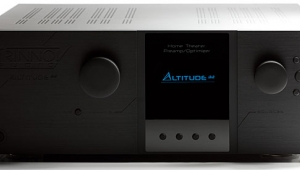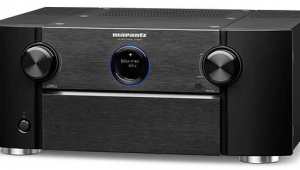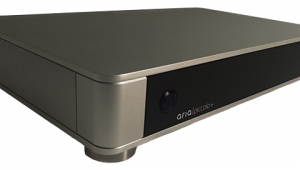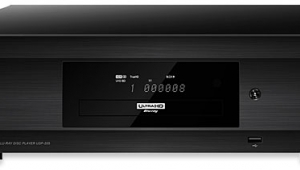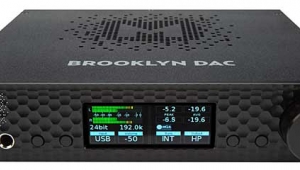| Columns Retired Columns & Blogs |
Music in the Round #16
In September 2005, for the first time, I attended the Expo of the Custom Electronic Design & Installation Association (CEDIA), in Indianapolis. Although I saw many familiar faces and companies, it was apparent that the event was dominated by a spirit very different from the one that pervades this magazine or the high-end exhibitions at the annual Consumer Electronics Show (CES). That spirit, however, does suffuse the rest of CES, and is well represented at Primedia's own Home Entertainment shows. That spirit encompasses video, and a view of audio that differs significantly from that of traditional audiophiles. Multichannel surround sound is taken as read, and novel technologies are prized higher than the proverbial "straight wire with gain."
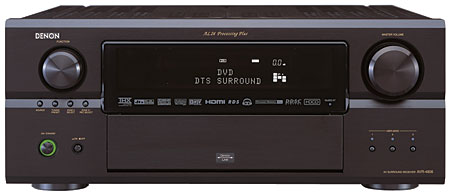
Shortly after my visit to Indianapolis, I attended the annual conference of the Audio Engineering Society (AES), here in Manhattan, and was surprised to find that most record producers, as well as most of the engineers who design the equipment they use, have more in common with the CEDIA approach than with ours.
Undoubtedly, I'd been sensitized by my own recent experiences. My multichannel system has become so complex, and so many of its functions lack obvious front-panel controls ("What? No volume knob?"), that I have to leave detailed lists of instructions so that my wife can operate it while I'm away. More than a half dozen remote controls are needed to operate it. Behind my equipment rack is a growing of tangle of cables, mostly audio but also video, that makes me feel like Snakemaster Austin Stevens when I swap components. I'm obsessed with acoustical room treatments and need objective guidance. Surely, there must be ways to keep one's audiophile standards for musical performance and sound quality intact while not sinking deeper and deeper into daunting complexity.
The reigning spirit at the CEDIA Expo seemed to promise that there are technologies to help with all of this—that you can set up a complex multichannel system without a PhD, that the connections will be simple and straightforward, that the operation of all functions will be integrated and logical, and that there are tools to ensure that the environment in which you listen can be easily treated to enhance accuracy and enjoyment. I'd love to see such systems, and those who exhibit at CEDIA seem to be trying hard to create them.
This contrasts starkly with the traditionalist two-channel approach that still encompasses a lot of high-end multichannel music-only systems. I've visited many homes, dealer showrooms, and audio-show demos, and the evidence indicates that most of us are still in the middle ages when it comes to new technology.
So to see what's going on outside our audiophile redoubt, I went over to the dark side for a while. Turning my back on the purist audio path I've tried to tread, I began to dream about how easy my listening life would be, and how much more music I could enjoy, if my equipment did more of the work for me. I could have chosen many different products to help me fulfill this dream, but Denon's top-of-the-line DVD-5910 universal disc player ($3500) and nearly-top-of-the-line AVR-4806 A/V receiver ($3500) are as talented as any, and are representative of good-quality, mainstream home theater gear. While this zaftig pair offers no savings in size or weight over separates, together they comprise a complete system, communicating with each other through a single audio cable (D-Link or FireWire). Connected to speakers, they offer setup facilities, such as speaker balancing and equalization, that are often relegated to platitudes in the back of traditional user's manuals. Also, Denon claims, they sound good. (As this is not a formal review, I refer you to Denon's website for detailed technical descriptions of these components.)

The DVD-5910 universal player will play nearly anything ever released on a 4¾" polycarbonate disc, and it has analog and S/PDIF outputs in addition to Denon's proprietary D-Link and the more-or-less standardized IEEE1394 (FireWire, iLink, etc.) encrypted digital audio outputs. Its dandy video features include a plethora of video outputs and the first consumer-product implementation of Silicon Optix's Realta-HQV video processor.
The AVR-4806 receiver has myriad inputs and decoding modes (including HDCD), 24-bit/192kHz Burr-Brown DACs, seven 130Wpc power amps, and can control and distribute audio to two additional zones. It has a phono input, an AM/FM tuner, and can receive XM satellite radio with the addition of a Connect&Play antenna. On the video front, the AVR-4806 has composite, S-video, component, DVI, and three HDMI inputs, the signals from which it can output in several ways, all available via its HDMI output. It also accepts stereo and multichannel analog inputs, and can bypass all digital processing between input and output except for the volume control (which is what I prefer to do). Most significant, the AVR-4806's format-decoding and bass-management facilities are accessible for DVD-Audio and SACD playback without redigitizing because the DVD-5910 can pass all audio to it in digital format via D-Link or FireWire. The AVR-4806's facilities also include automatic speaker setup and calibration and Audyssey MultEQxt Room Equalization. (A microphone and front-panel microphone jack are provided.)
But none of that is why I write this. What I examine here is the extent to which such products as the Denons—designed for the broad, mostly home-theater, market—meet the needs and standards of a high-end setup.
What's the setup?
Setup of the DVD-5910 is similar to that of other universal players, but simpler—all that's needed is one output, D-Link or iLink. Because of that, there's no need to bother with considering options for number of speakers, bass management, or the formatting of Dolby Digital or DTS signals. Video was equally easy, because all of the player's outputs are active all the time.
The multitalented AVR-4806 receiver is equally accommodating—after one accepts a paradigm shift in thinking. Despite a rear panel bristling with input and output connectors, none but the speaker terminals are usefully connected to anything inside the receiver out of the box. One must go into the Setup menu to connect the named source device to its physical connector(s). For my purposes, I simply selected D-Link as the input for DVD and, on the parallel video menu, HDMI as its video input, and I was good to go.
Here's where the rubber met the road. With older multichannel devices, the player, receiver, or preamplifier-processor must be told how many speakers there are, how big each of them is (Large, Small, None), how far (in distance or time) they are from the listener, and how to balance them for equal volume (in dB). Most of these devices can generate test tones for the balancing (you can also use a test disc) and advise you to use a sound-level meter instead of trusting your ears. Dolby and THX provide guidelines about what constitutes a Large (full-range) or Small (crossed over to a subwoofer at 80Hz) speaker, but those guidelines are specific to recordings and equipment made to Dolby or THX specs; they do not apply to SACD or DVD-Audio recordings, for which we must be more subtle. Like other sophisticated components, the AVR-4806 has multiple crossovers: 12 or 24dB/octave at 40, 60, 80, 100, 120, 150, 200, or 250Hz. That's almost too much freedom. Assessing all of those options subjectively would be mind-numbing, and most of us lack the instrumentation to do better.
Not to worry. Just plug the AVR-4806's little microphone into its jack and follow the simple onscreen instructions. I found it easiest to mount the mike on a tripod at the main listening position, but it can also be held in the hand. Hit Go and the Denon's Audyssey MultEQxt feature emits sweep tones sequentially from each output channel, and determines the presence of each speaker and whether its output is in phase. It then repeats the sweeps to adjust each output and its effective bandwidth for arrival time and level balance.
My results were very interesting. On the first pass, the AVR-4806 insisted that my right surround speaker was out of phase, but it corrected itself on retrials. Perhaps it was a little confused by the dipole radiation of my Magnepan MGMC-1 surround speaker, which sits pretty close to a corner. The distances calculated by the AVR-4806 for all the main speakers were pretty close to those I got with a tape measure, and probably more accurate. I'd thought my L/C/R front speakers were equidistant from the listening position; the AVR-4806 told me that the left was 2" closer than the others.
The speaker levels, too, were a little strange, and quite different from what I'd set with pink noise and a RadioShack sound-level meter. The AVR-4806 bumped up the front right channel by 1dB (to compensate for an open doorway nearby?), dropped the level of the center channel, raised the levels of the Magnepan rear surrounds by 8dB, and set the subwoofer level about 7dB lower. The AVR-4806 was adamant about these changes through several repetitions. My feeling is that my trusty RS meter was fooled by room modes that were excited by the wideband pink noise, while the Denon's gated sweeps gave a less biased assessment of overall levels. This was confirmed by sweep measurements with the TrueRTA program. The Denon's evaluation of the speakers was in agreement with my assessment: my three Paradigm Studio/60v.3 front speakers were deemed Large and the two Maggies Small, the latter thus needing to be crossed over to my Paradigm Servo-15 sub at 90Hz.
- Log in or register to post comments


